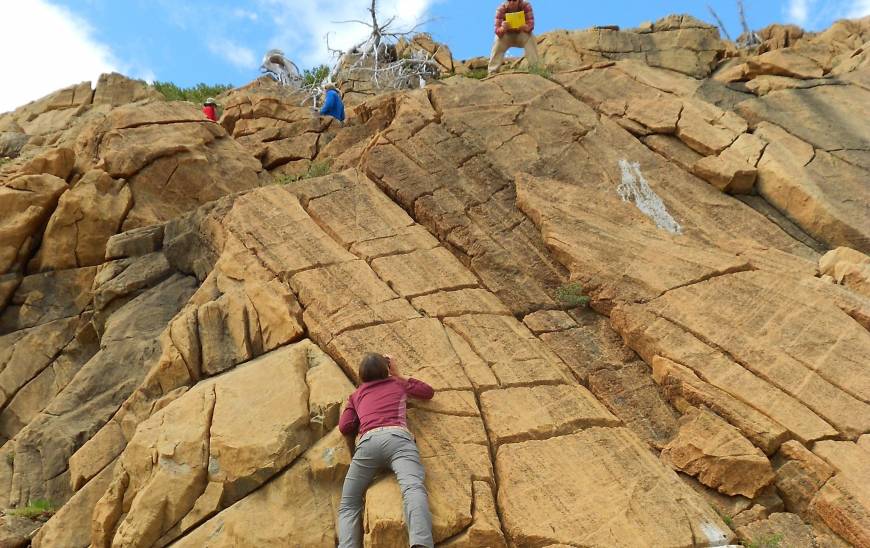The Stanford School of Earth, Energy & Environmental Sciences is now part of the Stanford Doerr School of Sustainability.
This page is currently being maintained for archival purposes only. For the latest information, please visit us here.
Powerful tool could unlock secrets of Earth’s interior ocean
A new way of determining the hydrogen content in mantle rocks could lead to improved estimates of Earth’s interior water and a better understanding of our planet’s early evolution.
By
Ker Than
<p>Stanford School Of Earth Sciences</p>
July 28, 2014
Megan D'Errico

<p>Graduate student Suzanne Birner and former postdoctoral researcher Lars Hansen collect structural data in the Josephine Peridotite in Oregon.</p>
A new technique for determining the hydrogen content of mantle rocks could lead to more precise estimates of how much water is contained in Earth’s deep interior and an improved understanding of our planet’s early evolution.
The rocks that make up the planet’s mantle, which extends from about 20 to 1,800 miles beneath the Earth’s surface, harbor hydrogen atoms within their crystal structures. Scientists estimate that if all of that hydrogen were converted to water–by combining with the oxygen that is naturally found in the planet’s interior–it would equal between half to four times as much water as is found in all of the Earth’s oceans combined. “Scientists used to think that there was not a lot of water inside the Earth because mantle minerals weren’t thought to be able to contain much water,” said Jessica Warren, an assistant professor in the department of Geological and Environmental Sciences at Stanford University.
In the late 1980s, however, scientists realized that minerals that were considered anhydrous, or lacking in water, actually can contain hydrogen atoms, but only at concentrations of a several parts per million. “That sounds miniscule, but if you multiply that by the volume of the mantle, it’s a very significant amount of water,” Warren said.
The amount of water contained in mantle rocks is known to influence geological processes such as volcanic eruptions. “The amount of water present within the Earth controls how explosive a volcanic eruption will be,” Warren said, “because during an eruption, there is a rapid pressure change and water dissolved in the magma is released as gas.”
Many scientists also suspect that mantle water directly influences the shift of the continents over geologic timescales. “The amount of water in the mantle controls its viscosity, or resistance to flow, and some scientists have argued that without water inside the Earth, you would not have plate tectonics,” Warren said.
A better understanding of how much water is locked away inside Earth could also help constrain models of our planet’s early evolution. “One long-standing question is how much water did our planet contain when it formed?” Warren said. “If we don’t know how much water is within the Earth today, it’s hard to project back to the past and model the early Earth and understand its formation.”
One reason that the estimates for how much water is inside the Earth vary so widely is that the mineral that scientists have traditionally used to estimate mantle water concentrations, called olivine, loses water over time. “Hydrogen diffuses out of olivine very quickly,” Warren explained. “Just the process of being transported from the mantle to the Earth’s surface results in water loss, so it’s difficult to estimate how much water an olivine sample once held.”
In a recent study, Warren and Erik Hauri, a geochemist at the Carnegie Institution of Washington, propose using pyroxene–the second-most abundant mantle mineral after olivine–as a proxy for estimating mantle water.
The pair analyzed several samples of peridotite, a rock that contains both olivine and different types of pyroxenes, which were collected from the seafloors of the Arctic and Indian Oceans and from a unique field site in Oregon. “When tectonic plates collide together, a slice of very deep material can get pushed up onto the crust,” Warren said. “At the field site in Oregon, we can actually walk around on what used to be the mantle.”
By comparing pyroxenes in the field rocks with samples that had been synthesized in the lab, Warren and Hauri concluded that pyroxene retains water better than olivine. The pair suggests that pyroxenes could be a “powerful tool” for estimating the concentration and location of water bound in minerals in the upper mantle. “Our results suggest that pyroxene does not have olivine’s water-loss problem,” Warren said.
It may be a while, however, before scientists can use pyroxenes to settle the question of just how much water is contained in the Earth’s mantle. “It’s a complicated calculation,” Warren said, “and we are still a long way off from actually being able to perform that estimate.”
The pair’s research was published earlier this year of the Journal of Geophysical Research: Solid Earth and was recently featured in Eos, a publication of the American Geophysical Union.
Ker Than is the associate director of communications for the School of Earth Sciences.







